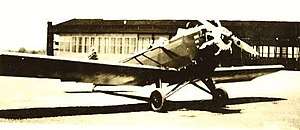Spartan C2
The Spartan C2 is a light aircraft produced in the United States in the early 1930s as a low-cost sport machine that would sell during the Great Depression.
| Spartan C2 | |
|---|---|
 | |
| Role | sport aircraft |
| National origin | United States |
| Manufacturer | Spartan Aircraft Company |
| Designer | Willis Brown[1] |
| First flight | 1931[2] |
| Number built | over 56[1] |

Design and development
The C2 is a conventional, low-wing monoplane design with two seats side-by-side in an open cockpit.[2][3] The wing was braced with struts and wires and it carried the main units of the divided fixed undercarriage. Power was supplied by a small radial engine mounted tractor-fashion in the nose, which drove a two-bladed propeller.
Spartan introduced the C2 in 1931 with a 55-hp engine, and sold 16 examples before ongoing economic circumstances brought production to a halt.[2] Spartan then built 2 examples with 165-hp engines to use in their own flying school. These latter aircraft were fitted with hoods that could be closed over the cockpit for training pilots in instrument flying.[1][4] Spartan offered this version to the U.S. military as a trainer,[5] but officials at the time believed that low-wing monoplanes were unsuitable for pilot training.[4] Spartan also tendered a proposal to the U.S. Bureau of Air Commerce to provide its inspectors with a two-seat light aircraft.[5] The design in question was probably the C2-60,[5] but in any case, the tender was not accepted.[5]
Variants
Operators
- Spartan School of Aeronautics (2 × C2-165)
Aircraft on display
Three C2s are preserved in museums — a restored example on display at the Tulsa Air and Space Museum,[6] a restored and flyable example at the Western Antique Aeroplane & Automobile Museum in Hood River, Oregon, and an example awaiting restoration at the Golden Wings Flying Museum, Blaine, Minnesota.[7]
Specifications (C2-60)
Data from Jane's all the World's Aircraft 1931,[8] Aerofiles: Spartan[1]
General characteristics
- Crew: 1
- Capacity: 1 pax
- Length: 22 ft 5.25 in (6.8390 m)
- Wingspan: 40 ft (12 m)
- Height: 6 ft 11.5 in (2.121 m)
- Wing area: 161.8 sq ft (15.03 m2)
- Airfoil: Clark Y
- Empty weight: 684 lb (310 kg)
- Gross weight: 1,125 lb (510 kg)
- Fuel capacity: Fuel:15 US gal (12 imp gal; 57 l); Oil:1.5 US gal (1.2 imp gal; 5.7 l)
- Powerplant: 1 × Jacobs L-3 3-cylinder air-cooled radial piston engine, 60 hp (45 kW)
- Propellers: 2-bladed metal propeller
Performance
- Maximum speed: 95 mph (153 km/h, 83 kn)
- Cruise speed: 80 mph (130 km/h, 70 kn) </li.
- Landing speed: 39 mph (34 kn; 63 km/h)
- Range: 320 mi (510 km, 280 nmi)
- Service ceiling: 13,000 ft (4,000 m) service
- Rate of climb: 800 ft/min (4.1 m/s) initial
- Wing loading: 6.96 lb/sq ft (34.0 kg/m2)
- Power/mass: 18.756 lb/hp (11.409 kg/kW)
See also
Aircraft of comparable role, configuration and era
References
| Wikimedia Commons has media related to Spartan Aircraft Company. |
- Notes
- "C2-60, -165", Aerofiles
- The Illustrated Encyclopedia of Aircraft, p.2955
- Taylor 1989, p.835
- "Spartan's Aircraft Manufacturing History"
- "The Spartan Aircraft Company"
- "Exhibits", Tulsa Air and Space Museum
- "Aircraft", Golden Wings Flying Museum
- Grey, C.G., ed. (1931). Jane's all the World's Aircraft 1931. London: Sampson Low, Marston & company, ltd. p. 316c.
- Bibliography
- "C2-60, -165". Aerofiles. Retrieved 2011-02-27.
- "The Spartan Aircraft Company". AirVenture Museum. Retrieved 2011-02-27.
- "Aircraft". Golden Wings Flying Museum. Archived from the original on 2011-01-20. Retrieved 2011-02-27.
- The Illustrated Encyclopedia of Aircraft. London: Aerospace Publishing. p. 2955.
- "Spartan's Aircraft Manufacturing History". Spartan College of Aeronautics and Technology. Retrieved 2011-02-27.
- Taylor, Michael J. H. (1989). Jane's Encyclopedia of Aviation. London: Studio Editions. p. 835.
- "Exhibits". Tulsa Air and Space Museum. Archived from the original on 2011-03-18. Retrieved 2011-02-27.